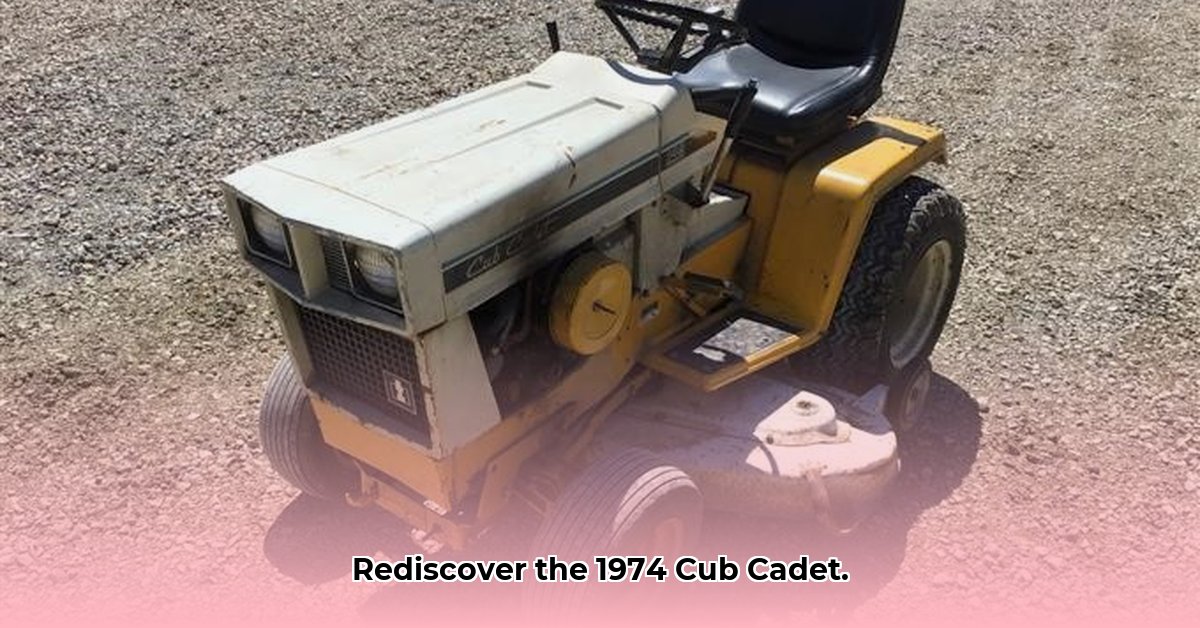
The 1974 Cub Cadet lawn tractor represents a pivotal moment in the evolution of compact garden tractors. Bridging the gap between early designs and modern machines, this model embodies the robust engineering and enduring appeal of a bygone era. This guide delves into its history, technical specifications, maintenance, restoration, and collector's value, offering both practical guidance and a fascinating glimpse into the past. For more modern Cub Cadets, check out this modern Cub Cadet resource.
A Legacy of Innovation: Cub Cadet's Early Years
Born from International Harvester (IH)'s expertise in farm equipment, the Cub Cadet line debuted in the early 1960s. Early models, while sharing design elements with larger tractors, underwent a continuous refinement process to better serve residential needs. The 1974 model exemplifies this evolution, showcasing enhanced features and improved usability for the average homeowner. Did you know early models borrowed heavily from IH's larger tractors, a testament to their engineering prowess?
Technical Specifications and Features: Under the Hood
The 1974 Cub Cadet models were typically powered by either a Kohler or Tecumseh engine, offering varying horsepower levels depending on the specific model. The transmission systems mostly used geared arrangements, providing straightforward operation and easy maintenance – a common feature of the time. Cutting deck sizes ranged from 38 to 48 inches, catering to diverse lawn sizes. Most models utilized a rear-wheel drive system, known for its reliability. Additional features often included headlights and various attachments to enhance functionality and convenience. Identifying your exact specifications requires locating the model number, usually stamped on the tractor itself. This number is key to unlocking your tractor’s unique history and specifications.
| Feature | Specifications | Additional Notes |
|---|---|---|
| Engine | Kohler or Tecumseh (horsepower varied) | Horsepower varied significantly between models. |
| Transmission | Mostly geared | Simple, robust design. |
| Cutting Deck Size | 38, 44, or 48 inches typically | Choice depended on lawn size. |
| Drive System | Rear-wheel drive | Reliable design common in that era. |
| Other Features | Headlights, attachments, varying seat options | Features enhanced comfort and functionality. |
Operation and Maintenance: Keeping Your Classic Running
Maintaining your 1974 Cub Cadet is crucial for preserving its longevity and performance. Regular maintenance, including oil changes, air filter replacements, and spark plug inspections, significantly extends the lifespan of these sturdy machines. Addressing minor issues promptly can prevent larger problems down the line. Finding replacement parts may require utilizing online resources, such as specialized parts suppliers and enthusiast forums.
Restoration and Parts Sourcing: Returning to Glory
Restoring a vintage Cub Cadet is a rewarding endeavor, offering a blend of mechanical challenge and historical preservation. However, it requires patience and access to appropriate resources. Online forums dedicated to Cub Cadet enthusiasts offer invaluable advice, part sourcing guidance, and troubleshooting support. Remember, many parts might require specialized suppliers or even fabrication.
Collector's Value and Market: A Growing Appreciation
The 1974 Cub Cadet has experienced a surge in popularity among collectors in recent years. Factors influencing value include rarity, condition, and originality. Meticulously restored models can command significant prices, reflecting the growing appreciation for well-engineered classic machinery. While some models from '74 are more valuable than others, detailed research specific to the model number is crucial for accurate valuation. What is the average price increase you can expect for a well-restored model?
Conclusion: A Timeless Icon
The 1974 Cub Cadet stands as a testament to enduring quality and design. Its continued appeal amongst collectors and enthusiasts underscores its historical significance and lasting value. Whether you’re a dedicated owner, aspiring restorer, or simply appreciate the charm of vintage machinery, this workhorse represents a fascinating piece of lawn care history.